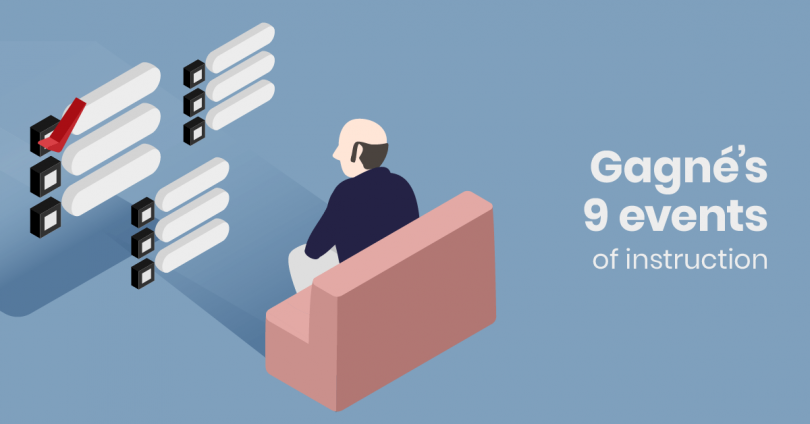The Nine Events of Instruction
- Shelly Davidson
- Aug 8, 2023
- 4 min read
Updated: Aug 10, 2023

Gagne’s theory is one of the amazing models. It is easy and straightforward to use by designers and Educators. In this model, when used in the classroom, the teacher can tailor the events to suit different learning topics. When combined with other training models, it can help new or experienced teachers create learning for all ages of students. It is a structured, logical, and systematic approach to creating instructional materials. It is diverse, can be adapted to different learning styles, and is effective for all learners. This model is based on constructivist learning theories. When used with Bloom’s Revised Taxonomy, it is possible to create engaging and meaningful instruction.

When you're ready to create extensive learning experiences or become an instructional designer, you'll want to know about Gagne's nine events.
Gagne's nine events include his research-backed principles that are necessary for learning to take place. Follow Gagne's nine events to make lesson plans, as these events are helpful, especially for new instructional designers and educators. These events don't have to be done in order, but having the audience's attention before starting is helpful.
We are going to cover each one of these in detail:
“The Nine Events of Instruction are:
Gain Attention: You can’t teach them if you can’t get their attention. You can do this with an engaging story, video animation, audio clip, and a thought-provoking question to get everyone focused on what's coming. You can be creative with how you gain attention.
Inform Learners of the Objectives: Now that you have their attention, you want to answer the questions like what the people will learn and what they will accomplish. Keep it simple; tell them where you're going with the learning experience you don't have to mention. Bloom's Taxonomy
Stimulate Recall of Prior Knowledge: The instructor must activate the learner’s prior knowledge, connect it to the new material and make t relevant to their world. Pick their brains and have learners fill out a survey. Your students learn by connecting new knowledge and new skills to knowledge and skills that you already have in their long-term memory.
Present the Material: Most teachers, facilitators, and designers know this step. Use images, manipulatives, or your voice to engage the students and chunk it well. Use songs or games and make sure the students can begin to understand the content. This will help them to stay focused on your content. Do not include anything irrelevant or unnecessary.
Provide Guidance: The instructor must guide and support the learner as they engage with the material. Scaffolding is one way to do this; at the beginning of the experience, you provide more guidance and help them see the reasoning behind specific answers or certain approaches. You give them little tips and tricks to remember things, learn the information, practice the skills they know, and help them efficiently learn the content.
Elicit Performance: The learner must demonstrate their understanding of the material through activities and exercises. Provide practice opportunities, so they learn new skills. You need to ensure they have a chance to practice and don't just dump the content on them.
Provide Feedback: Provide frequent feedback to the learners on their performance and give chances for peer feedback. Providing feedback goes hand in hand with delivering those practice opportunities.
Assess Performance: The instructor must assess the learner's performance to determine if the objectives have been met at the end of the experience. We can assess the learning and make it fun. One way is a multiple-choice assessment. This assessment allows us to evaluate the course content and the designer.
Enhance Transfer: You want people to take away what they learned and use it in real life. One of the best ways to do this is role play or discuss hypothetical real-world situations. The class can be given the option to use this new knowledge or new skills in a mock situation.
In conclusion, I hope that helped. Those are Gagne's nine events, and again, they can be used in any order. You will probably want to think about these at every stage of your design process. If you are new to designing lessons or haven't developed a learning experience, try following this in order and checking all the boxes. Now let us see an Application.
References
Administrator. (2023, June 9). Three basic steps of backward design lesson plans [+faqs]. University of San Diego - Professional & Continuing Education. https://pce.sandiego.edu/backward-design-in-education/
DeBell, A. (2022a, December 14). How to use Gagne’s nine events of instruction [examples]. Water Bear Learning. https://waterbearlearning.com/how-to-use-gagnes-nine-events/
Heick, T. (2023, July 18). What is Bloom’s taxonomy? A definition for teachers. TeachThought. https://www.teachthought.com/learning/what-is-blooms-taxonomy
Mcleod, S. (2023, June 15). Constructivism learning theory & philosophy of education. Simply Psychology. https://www.simplypsychology.org/constructivism.html
Pavlou, C. (2021, September 2). Gagne’s nine events of instruction: Definition, examples, and applications in eLearning. eFront Blog. https://www.efrontlearning.com/blog/2021/09/gagnes-nine-events-of-instruction.html
Samrat Sahais,(2023, March 4). The Ultimate Guide to Gagne’s nine events of learning. SimpliMBA. https://www.simplimba.com/gagnes-9-events-theory/#Conclusion
Serhat, K. (2021, January 4). Robert Gagné’s Taxonomy of Learning. Educational Technology. https://educationaltechnology.net/robert-gagnes-taxonomy-of-learning/
YouTube. (2019a). Event 8 in Gagne’s Nine Events of Instruction: Assess Performance. YouTube. Retrieved from https://www.youtube.com/watch?v=QpjPnEJYe68&ab_channel=J.ClarkGardner.
YouTube. (2015). Robert Gagne. YouTube. Retrieved from https://www.youtube.com/watch?v=FgDcUnObLqI&ab_channel=catio23.

Comments